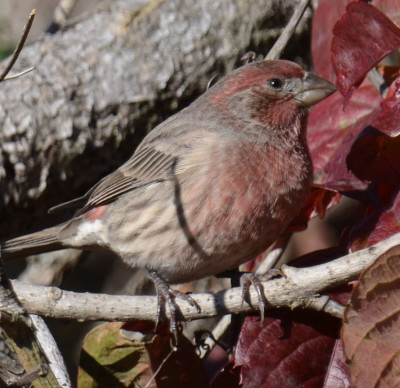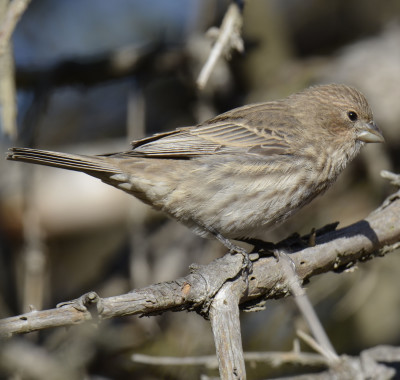Twenty-five years ago, many people living in Ontario and nearby provinces and states had grown accustomed to seeing a red or pink “sparrow” at their feeder. The birds cheerful singing brightened up many of my morning walks. Then they were almost wiped out by a disease and these little Western birds became rare again in my part of the East. Recently, though, they seem to be making a come back so you may see a rosy House Finch at your feeder or in your trees, too.
What Sparrow-sized Finch Has a Red Head, Red Cheek, Bright Red Chest, Brown Side Streaks and Red Spot Above the Tail?
Male House Finches are vivid and in some lights can even look as red as a male Cardinal. The strong dark streaks on their lower front and sides are an important identity clue. They have a sturdy, perhaps even over-sized looking bill. And they sing well.
Female House Finches are much less colourful. Their bill and their generous streaking on the front help to identify them. Fortunately, they also are usually hanging out with one or more males to help clarify the id.
Isn’t This a Purple Finch?
Older field guides to Eastern birds may not mention House Finches. They originally were a Western bird but their range has shifted and they are now found throughout North America. According the AllAboutBirds website the eastern birds are descendents of ones released in New York state.
Previously, the only common red finch in eastern Ontario was the Purple Finch. Purple Finches, which are more red than violet, don’t have the generous dark streaks on the front and sides. They are also red on the nape of the neck and down the back onto the tops of the wings. Purple Finches also tend to nest a bit further north than southern Ontario. During migration, though, it’s possible to see a Purple Finch moving through Mississauga or Toronto.
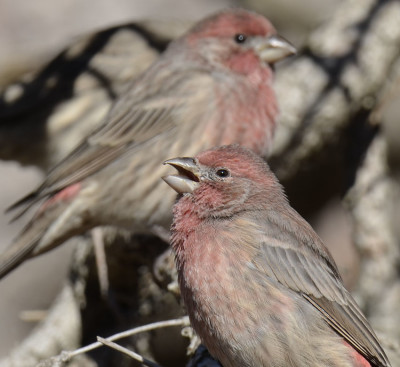
If I ever find an easy way to record sounds well, you’ll be able to hear as well as “see” finches like these singing.
What Decimated the House Finch Population?
A disease called mycoplasmal conjunctivitis swept through the House Finch population, starting in the east, with a noticeable impact starting in 1994. This disease causes red puffy eyes but it also causes respiratory difficulties according to the Cornell website. The disease affected the eyes so badly that many of the infected birds died of hunger or predation. At the time, bird watchers were told it would be good to disinfect feeders regularly as the disease could be spread to the next bird coming to eat.
There is a lot of information about the disease on this website.
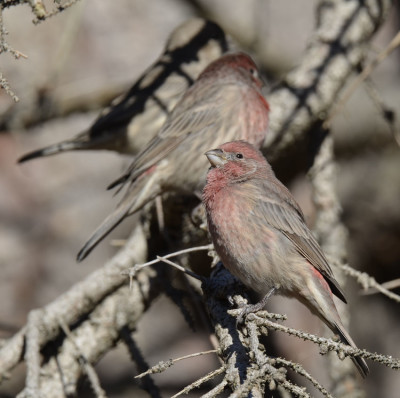
House Finches are social as you can see. This added to the rapid spread of the disease.
Apparently, the disease has now swept through the population and although it is still a problem the birds numbers have recovered.
Certainly I have seen quite a few House Finches in the past three years. We have a pair that raises a family in a nest in our back yard. And I’ve seen them in several of the local parks. On a frosty mid-October morning at Riverwood, I found 7 (3 males and 4 females) sunning themselves in an old spruce tree. I hope to see some of them this winter at the feeders there: their red plumage adds a cheerful note.
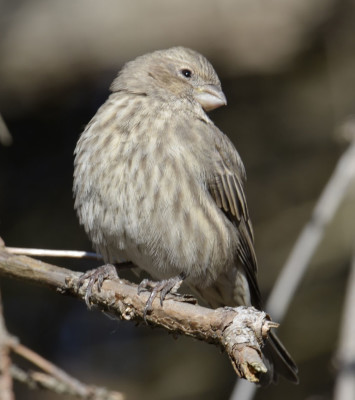
Something about the shape of their bills and the set of their eyes makes some House Finches look like they are sneering.
Related Reading
- Goldfinch on Goldenrod
- What Brown Sparrow Has a Bi-colour Beak?
- Pine Siskins at Saddington in Mississauga
- What “Sparrow” Has a Thumb-print-sized Red Cap and a Blush of Pink on Its Chest?
Join In
Do House Finches visit your feeder? Please share your sighting with a comment.

